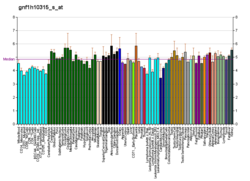Prokineticin_receptor_2
Prokineticin receptor 2
Protein-coding gene in the species Homo sapiens
Prokineticin receptor 2 (PKR2), is a dimeric[5] G protein-coupled receptor encoded by the PROKR2 gene in humans.[6]
| PROKR2 | |||||||||||||||||||||||||||||||||||||||||||||||||||
|---|---|---|---|---|---|---|---|---|---|---|---|---|---|---|---|---|---|---|---|---|---|---|---|---|---|---|---|---|---|---|---|---|---|---|---|---|---|---|---|---|---|---|---|---|---|---|---|---|---|---|---|
| Identifiers | |||||||||||||||||||||||||||||||||||||||||||||||||||
| Aliases | PROKR2, GPR73L1, GPR73b, GPRg2, HH3, KAL3, PKR2, dJ680N4.3, prokineticin receptor 2 | ||||||||||||||||||||||||||||||||||||||||||||||||||
| External IDs | OMIM: 607123 MGI: 2181363 HomoloGene: 16368 GeneCards: PROKR2 | ||||||||||||||||||||||||||||||||||||||||||||||||||
| |||||||||||||||||||||||||||||||||||||||||||||||||||
| |||||||||||||||||||||||||||||||||||||||||||||||||||
| |||||||||||||||||||||||||||||||||||||||||||||||||||
| |||||||||||||||||||||||||||||||||||||||||||||||||||
| |||||||||||||||||||||||||||||||||||||||||||||||||||
| Wikidata | |||||||||||||||||||||||||||||||||||||||||||||||||||
| |||||||||||||||||||||||||||||||||||||||||||||||||||
Prokineticins are secreted proteins that can promote angiogenesis and induce strong gastrointestinal smooth muscle contraction. The protein encoded by this gene is an integral membrane protein and G protein-coupled receptor for prokineticins. PKR2 is composed of 384 amino acids. Asparagine residues at position 7 and 27 undergo N-linked glycosylation.[5] Cysteine residues at position 128 and 208 form a disulfide bond.[5] The encoded protein is similar in sequence to GPR73, another G protein-coupled receptor for prokineticins.[6] PKR2 is also linked to mammalian circadian rhythm.[7] Levels of PKR2 mRNA fluctuate in the suprachiasmatic nucleus, increasing during the day and decreasing at night.[7]
Mutations in the PROKR2 (also known as KAL3) gene have been implicated in hypogonadotropic hypogonadism and gynecomastia.[8] Total loss of PKR2 in mice leads to spontaneous torpor usually beginning at dusk and lasting for 8 hours on average.[9]
PKR2 functions as a G protein-coupled receptor, thus it has a signaling cascade when it's ligand binds. PKR2 is a Gq-coupled protein, so when the ligand binds, beta-type phospholipase C is activated which creates inositol triphosphate. This then triggers calcium release inside the cell.[10]
- "Human PubMed Reference:". National Center for Biotechnology Information, U.S. National Library of Medicine.
- "Mouse PubMed Reference:". National Center for Biotechnology Information, U.S. National Library of Medicine.
- Sposini S, Caltabiano G, Hanyaloglu AC, Miele R (January 2015). "Identification of transmembrane domains that regulate spatial arrangements and activity of prokineticin receptor 2 dimers". Molecular and Cellular Endocrinology. 399: 362–372. doi:10.1016/j.mce.2014.10.024. hdl:10044/1/31246. PMID 25449422. S2CID 13491537.
- Masumoto KH, Nagano M, Takashima N, Hayasaka N, Hiyama H, Matsumoto S, et al. (June 2006). "Distinct localization of prokineticin 2 and prokineticin receptor 2 mRNAs in the rat suprachiasmatic nucleus". The European Journal of Neuroscience. 23 (11): 2959–2970. doi:10.1111/j.1460-9568.2006.04834.x. PMID 16819985. S2CID 20510543.
- Jethwa PH, I'Anson H, Warner A, Prosser HM, Hastings MH, Maywood ES, Ebling FJ (June 2008). "Loss of prokineticin receptor 2 signaling predisposes mice to torpor". American Journal of Physiology. Regulatory, Integrative and Comparative Physiology. 294 (6): R1968–R1979. doi:10.1152/ajpregu.00778.2007. PMC 2735815. PMID 18417646.
- Martin C, Balasubramanian R, Dwyer AA, Au MG, Sidis Y, Kaiser UB, et al. (April 2011). "The role of the prokineticin 2 pathway in human reproduction: evidence from the study of human and murine gene mutations". Endocrine Reviews. 32 (2): 225–246. doi:10.1210/er.2010-0007. PMC 3365793. PMID 21037178.
- Lin DC, Bullock CM, Ehlert FJ, Chen JL, Tian H, Zhou QY (May 2002). "Identification and molecular characterization of two closely related G protein-coupled receptors activated by prokineticins/endocrine gland vascular endothelial growth factor". The Journal of Biological Chemistry. 277 (22): 19276–19280. doi:10.1074/jbc.M202139200. PMID 11886876. S2CID 22935718.
- Soga T, Matsumoto Si, Oda T, Saito T, Hiyama H, Takasaki J, et al. (December 2002). "Molecular cloning and characterization of prokineticin receptors". Biochimica et Biophysica Acta (BBA) - Gene Structure and Expression. 1579 (2–3): 173–179. doi:10.1016/S0167-4781(02)00546-8. PMID 12427552.
- Battersby S, Critchley HO, Morgan K, Millar RP, Jabbour HN (May 2004). "Expression and regulation of the prokineticins (endocrine gland-derived vascular endothelial growth factor and Bv8) and their receptors in the human endometrium across the menstrual cycle". The Journal of Clinical Endocrinology and Metabolism. 89 (5): 2463–2469. doi:10.1210/jc.2003-032012. PMID 15126578.
- Pasquali D, Rossi V, Staibano S, De Rosa G, Chieffi P, Prezioso D, et al. (September 2006). "The endocrine-gland-derived vascular endothelial growth factor (EG-VEGF)/prokineticin 1 and 2 and receptor expression in human prostate: Up-regulation of EG-VEGF/prokineticin 1 with malignancy". Endocrinology. 147 (9): 4245–4251. doi:10.1210/en.2006-0614. PMID 16763065.
- Dodé C, Teixeira L, Levilliers J, Fouveaut C, Bouchard P, Kottler ML, et al. (October 2006). "Kallmann syndrome: mutations in the genes encoding prokineticin-2 and prokineticin receptor-2". PLOS Genetics. 2 (10): e175. doi:10.1371/journal.pgen.0020175. PMC 1617130. PMID 17054399.
- GeneReviews/NCBI/NIH/UW entry on Kallmann syndrome
- "Prokineticin Receptors: PKR2". IUPHAR Database of Receptors and Ion Channels. International Union of Basic and Clinical Pharmacology. Archived from the original on 2009-07-17. Retrieved 2008-12-09.
This transmembrane receptor-related article is a stub. You can help Wikipedia by expanding it. |
This article incorporates text from the United States National Library of Medicine, which is in the public domain.




